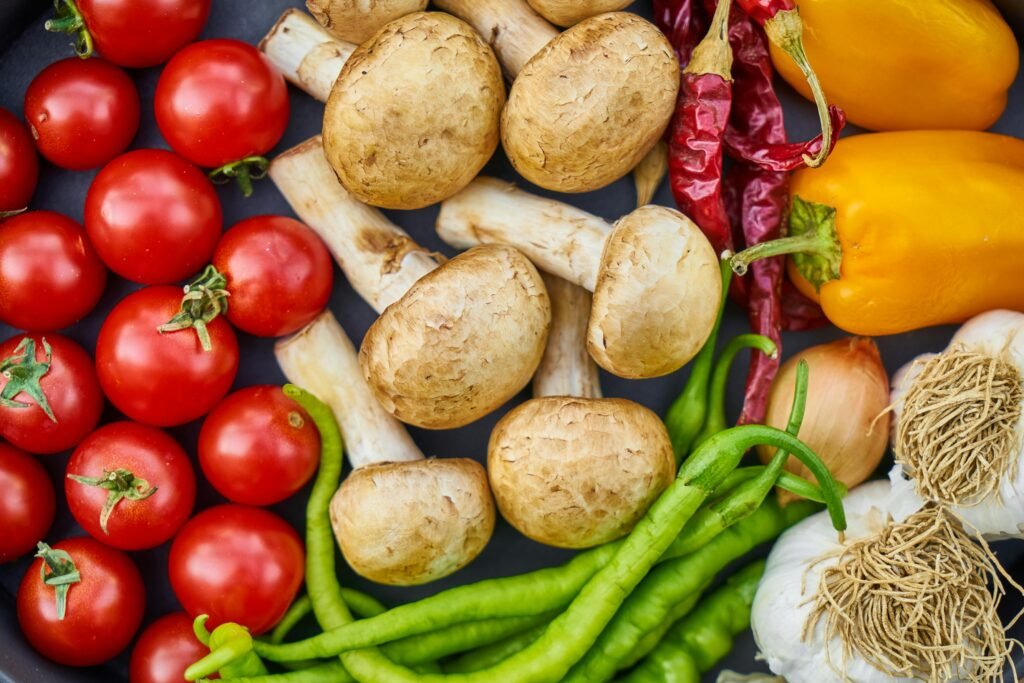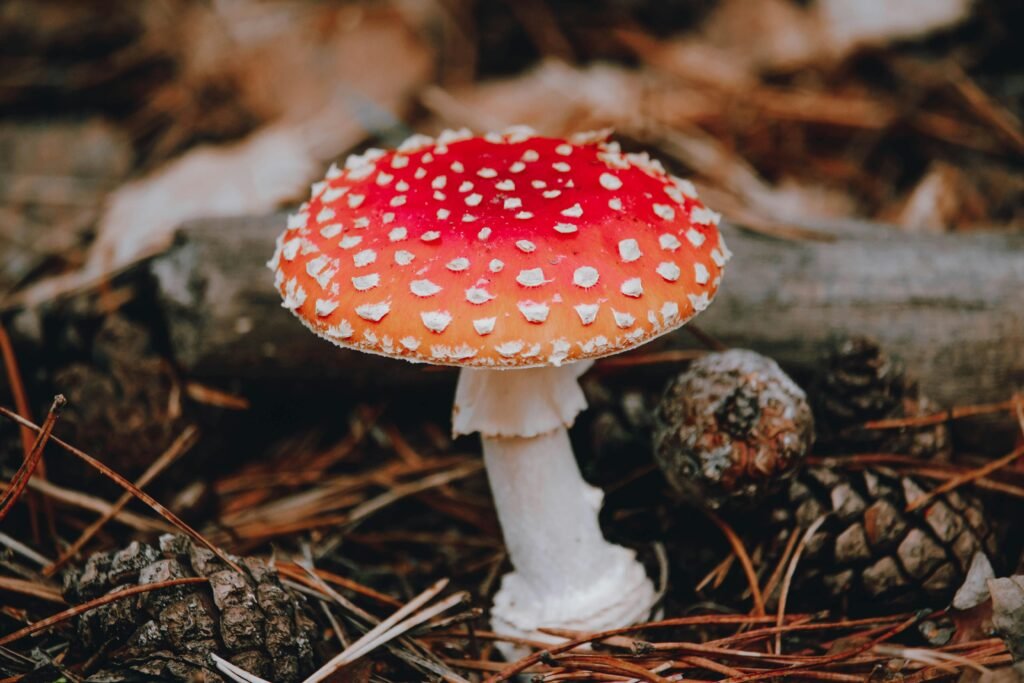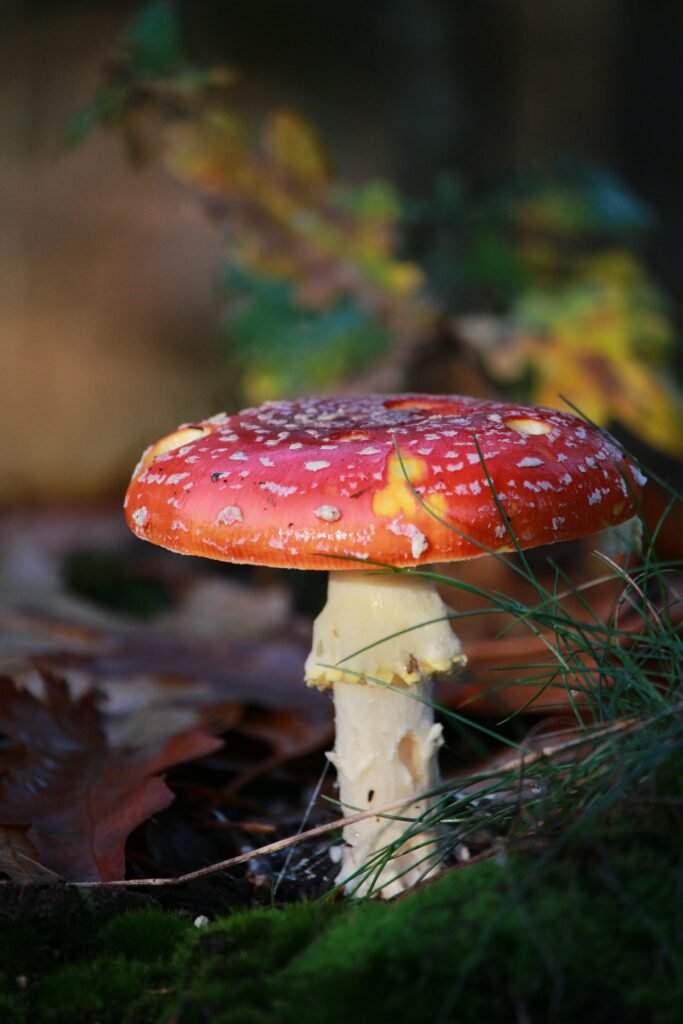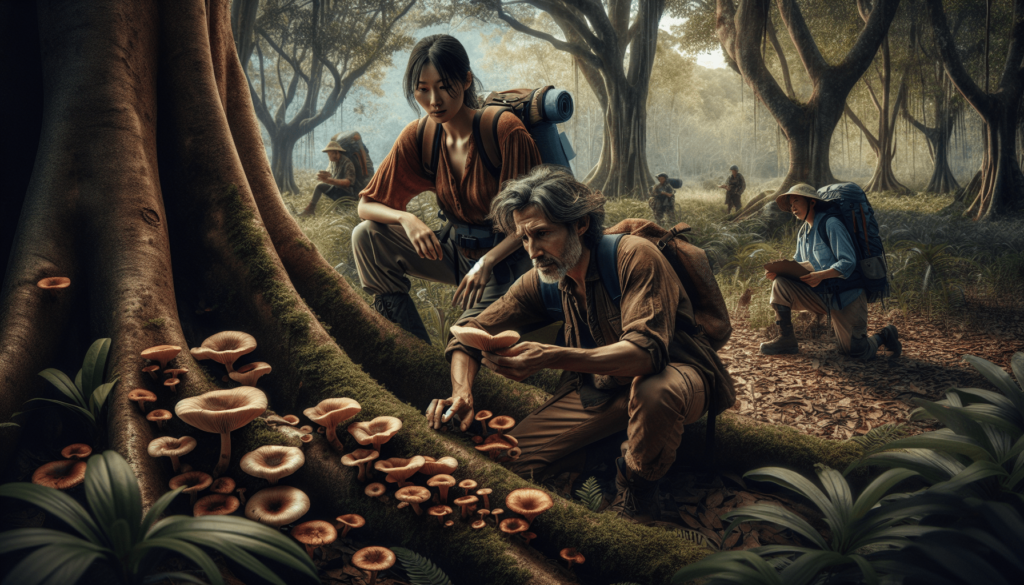Imagine stepping into a mystical world filled with an array of shapes, colors, and textures. A world where you become a hunter, not for prey, but for nature’s hidden treasures – mushrooms. In this captivating article, we will explore the fascinating world of mushroom hunters, their craft, and the exhilarating adventure that awaits those who embark on this unique quest. Get ready to uncover the secrets of the forest floor and discover the captivating world of mushroom hunting.

What is mushroom hunting?
Definition of mushroom hunting
Mushroom hunting, also known as mushroom foraging, is the activity of searching for and collecting mushrooms in their natural habitats. It is a popular recreational and educational pursuit for individuals who have an interest in mycology, the study of fungi. Mushroom hunters explore various environments, from forests to fields, in search of different mushroom species.
Purpose of mushroom hunting
The primary purpose of mushroom hunting is the discovery and collection of edible mushrooms for culinary use. Mushroom enthusiasts enjoy the thrill of finding rare and delicious varieties, which can enhance their meals with unique flavors and textures. Additionally, mushroom hunting contributes to scientific research, as enthusiasts often record and report their findings, aiding in the study of fungi and their ecological role.
History of mushroom hunting
Mushroom hunting has a long history, with evidence of people gathering and using mushrooms dating back thousands of years. In many cultures, mushrooms have been valued for their medicinal properties and as a source of sustenance. Traditional knowledge of mushroom habitats and species has been passed down through generations and continues to be shared among mushroom hunting communities today.
Where do mushroom hunters look for mushrooms?
Types of environments favored by mushrooms
Mushrooms can be found in a variety of environments, but certain conditions are more favorable for their growth. Forests, particularly those with a diverse range of trees and vegetation, provide ample opportunities for mushroom hunting. Moisture, shade, and decaying organic matter are essential elements for mushroom growth, making areas with fallen trees, leaf litter, and rotting logs prime locations for exploration.
Specific habitats of certain mushroom species
Different mushroom species have specific preferences when it comes to their habitats. Some mushrooms thrive in grassy meadows, while others are more commonly found in coniferous forests or near rivers and streams. Mycorrhizal mushrooms have a symbiotic relationship with certain tree species, and therefore, can be found in close proximity to their host trees. Understanding these preferences can help mushroom hunters narrow down their search and increase their chances of finding desired species.
Popular locations for mushroom hunting
While mushrooms can be found in various locations around the world, there are certain regions that are renowned for their abundance and diversity of mushrooms. The Pacific Northwest of the United States, including Oregon and Washington, is famous for its rich fungal biodiversity. European countries like Italy and France are also well-known for their truffle hunting traditions. National parks, nature reserves, and local forests often attract mushroom hunters due to the diversity of habitats and the presence of knowledgeable enthusiasts.
Tools and equipment used by mushroom hunters
Basic tools for mushroom hunting
To embark on a successful mushroom hunting expedition, there are some essential tools that every enthusiast should have. A sturdy basket or foraging bag is crucial for safely collecting mushrooms and preventing them from getting damaged. A knife with a sharp blade is essential for cleanly cutting the mushrooms at the stem. Additionally, a field guide or a smartphone app dedicated to mushroom identification is invaluable for accurately identifying and learning about different mushroom species.
Optional specialized equipment for mushroom hunting
While not necessary for beginners, some advanced mushroom hunters may invest in specialized equipment to enhance their foraging experience. A mushroom brush or a soft-bristle brush can be used to carefully clean dirt and debris from the mushrooms without damaging their delicate caps. A handheld magnifying glass or a macro lens attachment for a smartphone can aid in examining small and intricate features on mushrooms for accurate identification.
Safety gear for mushroom hunting
Safety should always be a top priority for mushroom hunters, as some mushrooms can be toxic or poisonous. It is important to wear protective gloves, especially when handling potentially harmful species. A first aid kit should also be carried in case of minor injuries. Additionally, it is advisable to wear appropriate clothing and footwear for the terrain, including waterproof boots, as mushroom hunting often involves venturing into damp and uneven environments.
Identification skills of mushroom hunters
Knowledge of mushroom species
Successful mushroom hunters possess in-depth knowledge of various mushroom species, including their preferred habitats, seasonal variations, and physical characteristics. This knowledge is acquired through years of experience, studying field guides, and learning from fellow enthusiasts. The ability to accurately identify different mushroom species is crucial for determining their edibility and distinguishing between toxic and non-toxic mushrooms.
Identifying edible mushrooms
One of the main objectives of mushroom hunting is to find edible mushrooms. To identify these culinary treasures, mushroom hunters rely on a combination of visual cues, scent, and other distinguishing features. Characteristics such as cap shape, color, gill structure, spore print color, and the presence of a unique aroma can all provide clues in determining whether a mushroom is safe for consumption. However, it is essential to cross-reference findings with trusted sources to ensure accurate identification.
Differentiating between toxic and non-toxic mushrooms
Differentiating between toxic and non-toxic mushrooms is an essential skill for the safety of mushroom hunters. While some mushroom species may appear visually similar to edible varieties, they can be extremely poisonous. Mushroom hunters must be aware of distinguishing features, such as the presence of a universal veil, which may indicate the potential toxicity of a mushroom. In cases of uncertainty, it is always best to err on the side of caution and seek expert advice before consuming any mushrooms.

Foraging techniques employed by mushroom hunters
Spotting mushrooms in the wild
One of the primary techniques employed by mushroom hunters is the art of spotting mushrooms in their natural habitats. This skill comes with practice and experience, as different mushroom species can blend into their surroundings and can be easily missed by the untrained eye. Attention to detail and a keen observation of the environment are key factors in spotting mushrooms and increasing the likelihood of a successful foraging trip.
Using scent and visual cues to find mushrooms
In addition to visual cues, mushrooms often emit distinct odors that can help guide mushroom hunters to their location. Some mushrooms have a strong, pleasant aroma that is characteristic of their species, while others have a more earthy or pungent scent. By honing their sense of smell and being attuned to these aromatic cues, mushroom hunters can narrow down the search for specific mushrooms and improve their overall success rate.
Methods to efficiently collect mushrooms
Efficiency is important when it comes to collecting mushrooms, as improper harvesting techniques can damage the delicate fungi and impact their ability to reproduce. Rather than pulling mushrooms from the ground, it is recommended to cut them cleanly at the stem using a sharp knife. This method allows the mycelium, the underground network of fungal threads, to remain intact and potentially produce more mushrooms in the future. Placing the harvested mushrooms gently in a basket or foraging bag helps prevent bruising or crushing.
Ethical considerations in mushroom hunting
Respecting natural habitats and ecosystems
Mushroom hunters must prioritize the preservation of natural habitats and ecosystems. It is essential to tread lightly, avoiding trampling on vegetation or damaging fungal mycelium while foraging. Taking care to minimize any disturbance to the environment ensures the sustainability and regenerative capacity of mushroom populations for future generations.
Limitations on harvesting mushrooms
To maintain healthy populations of mushrooms, it is important to adhere to certain limitations on harvesting. Responsible mushroom hunters avoid overharvesting in a single area to prevent the depletion of mushroom populations and allow them to propagate naturally. Abiding by local regulations and guidelines, understanding seasonal variations, and practicing restraint are all crucial in ensuring the long-term sustainability of mushroom habitats.
Conservation efforts in mushroom hunting
Many mushroom hunters actively participate in conservation efforts to protect and restore mushroom habitats. This can involve volunteering for habitat restoration projects, supporting organizations dedicated to fungi conservation, or engaging in citizen science initiatives that contribute to ongoing research and monitoring of fungal ecosystems. By promoting awareness and actively participating in conservation, mushroom hunters play a vital role in preserving fungal biodiversity.

Dangers and risks associated with mushroom hunting
Poisonous mushroom species
One of the most significant risks associated with mushroom hunting is the potential for encountering poisonous mushroom species. Some toxic mushrooms may closely resemble edible varieties, making accurate identification essential for personal safety. Ingesting even a small amount of certain poisonous mushrooms can lead to severe illness or even be fatal. It is crucial to continuously educate oneself about regional poisonous mushrooms and consult experts or trusted sources when in doubt.
Environmental hazards
While exploring natural environments, mushroom hunters may encounter various environmental hazards. Slippery or uneven terrain, dense vegetation, and unpredictable weather conditions can pose risks such as falls, bruises, or exposure to extreme temperatures. Awareness of one’s surroundings, proper equipment, and cautious navigation are important to minimize these hazards and ensure a safe foraging experience.
Physical risks during foraging
Physical risks can also arise during the act of foraging itself. Handling sharp knives or tools requires attentiveness and caution to prevent accidents or injuries. Mushroom hunters should be mindful of their surroundings to avoid accidentally disturbing wildlife, such as venomous snakes or stinging insects. Additionally, certain mushroom species may produce spores or release toxins that can irritate the respiratory system, so wearing a mask or taking precautions to minimize inhalation is advisable.
Culinary uses of mushrooms found by hunters
Recipes and cooking techniques for various mushroom species
One of the most rewarding aspects of mushroom hunting is the opportunity to bring a bountiful harvest into the kitchen and explore different culinary possibilities. Mushroom hunters often develop their own unique recipes or adapt existing ones to highlight the flavors and textures of the mushrooms they find. From simple sautés to complex stews and sauces, there are endless cooking techniques and flavor combinations to experiment with.
Preservation methods for harvested mushrooms
To extend the shelf life and enjoy the harvested mushrooms beyond the foraging season, mushroom hunters employ various preservation methods. Drying mushrooms is a popular technique, as it concentrates their flavors and allows for long-term storage. Other methods include pickling, canning, or freezing mushrooms, depending on the desired outcome and personal preferences. Proper cleaning, preparation, and storage techniques are crucial to maintain the quality and safety of preserved mushrooms.
Sharing and trading mushrooms
Mushroom hunting often fosters a sense of community, and many enthusiasts enjoy sharing their finds with others. Exchanging mushrooms and trading different varieties with fellow hunters allows for the exploration of new flavor profiles and expands one’s knowledge of mushroom species. Sharing recipes, tips, and experiences within mushroom hunting communities further enriches the overall enjoyment of the hobby.

Mushroom hunting communities and organizations
Local mushroom hunting groups and clubs
Joining local mushroom hunting groups or clubs is an excellent way to connect with like-minded enthusiasts, share knowledge, and gain valuable insights into regional mushroom species and habitats. These communities often organize group forays, where members explore different areas together and learn from experienced hunters. Club meetings, workshops, and events provide opportunities to engage in discussions, attend educational presentations, and foster a sense of camaraderie within the mushroom hunting community.
Online forums and resources for mushroom hunters
The internet has facilitated the exchange of information and resources within the mushroom hunting community. Online forums, websites, and social media platforms enable enthusiasts from around the world to connect, ask questions, and share their experiences. These platforms often host discussions, feature identification guides, and provide access to scientific research and educational material. Online resources can be particularly useful for beginners looking to expand their knowledge and connect with experienced mushroom hunters.
Participating in organized mushroom forays
Organized mushroom forays are events organized by mushroom hunting communities, clubs, or educational institutions. These forays bring together seasoned hunters, experts, and beginners to explore new areas, learn about different mushroom species, and share insights. Guided walks, educational workshops, and hands-on identification sessions are common elements of these forays, providing a wealth of information and fostering a sense of community among participants.
Contribution to scientific research and conservation
Recording and reporting findings
Mushroom hunters play a valuable role in scientific research and monitoring efforts by recording and reporting their findings. Documenting the location, date, and details of mushroom discoveries can aid in mapping distribution patterns, identifying new species, and understanding seasonal variations. Sharing this information with relevant organizations and researchers can contribute to ongoing ecological studies and conservation initiatives.
Participating in citizen science projects
Mushroom hunters can actively engage in citizen science projects related to fungi and their ecological role. These initiatives involve data collection, such as mushroom surveys, monitoring changes in fungal populations, or documenting interactions between fungi and other organisms. Citizen science projects provide opportunities for mushroom hunters to contribute to the scientific community’s knowledge and support conservation efforts.
Assisting in the study of fungi and their ecological role
By observing and interacting with mushrooms in their natural habitats, mushroom hunters gain valuable insights into the ecology and behavior of these fascinating organisms. Informal observations can provide researchers with important data related to mycelium networks, nutrient cycling, and the relationships between fungi and other organisms. This passive role in assisting scientific research contributes to a better understanding of the ecological role of fungi and their impact on ecosystems.
In conclusion, mushroom hunting is a multifaceted activity that combines the joy of exploration, culinary creativity, scientific inquiry, and conservation efforts. With proper knowledge, skills, and equipment, mushroom hunters can safely and responsibly forage for a variety of mushroom species. From identifying edible mushrooms to recording findings and contributing to scientific research, mushroom hunting offers a unique and rewarding experience for enthusiasts of all levels. So grab your basket, take to the woods, and immerse yourself in the captivating world of mushrooms!

